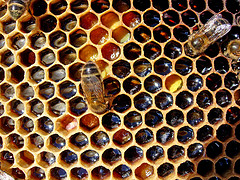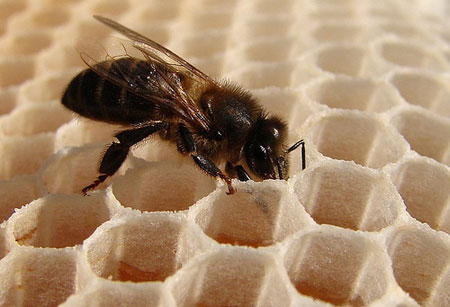Lord of the heavens and the earth and everything between them,the Almighty, the Endlessly Forgiving.’ (Surah Sâd: 66)
One of the most amazing distinctions about bees is the hexagonal comb cells they make. Watching a large group of bees building honeycombs, one assumes that the end result must be total confusion. There seems little chance that these insects, which all seem to be acting independently of one another, could ever produce such imposing structures. Contrary to appearances, however, bees work together in building the comb, in total harmony and in an exceedingly ordered manner. In fact, although they start from different points, they all build cells of exactly the same size. The joins where they meet in the middle are invisible, and there is never any error in the angles of their hexagons. Bees build combs only when there is a need in the hive. They build these for shelter, storing food and raising larvae, and every aspect of the combs is regulated. Each is double-sided, for instance, with cells sharing a common base; and each comb face can have hundreds or even thousands of cells, produced in an ordered manner to be filled with honey, pollen and eggs.
Bees build combs only when there is a need in the hive. They build these for shelter, storing food and raising larvae, and every aspect of the combs is regulated. Each is double-sided, for instance, with cells sharing a common base; and each comb face can have hundreds or even thousands of cells, produced in an ordered manner to be filled with honey, pollen and eggs.
The top of the comb down to the middle is filled with honey. Pollen is stored underneath these, with eggs at the very bottom. The honey stores also continue at the sides of the hive. However, the workers always store a few rows of pollen between the larval chambers and those used for honey.120 This prevents the three contents-honey, larvae and pollen from becoming mixed up in the near-total darkness of the hive. Honey and larvae being kept separate is very definitely most of all to humans' benefit, otherwise bee-keepers would face an irresoluble problem: Seeking to separate one part of the honeycomb in their efforts to extract the honey would inevitably harm the new members of the colony. The presence of larvae in the honey would also make it far less palatable.
Again, conscious behavior permits this separation. In appearance, there is no difference among the cells in the comb for larvae, pollen and honey-they are all identical. But despite this resemblance, as we have already seen, the queen never makes the mistake of laying her eggs in empty cells intended for honey or pollen, but always lays them in the right place. No doubt that this is a discriminating ability given her by God.



